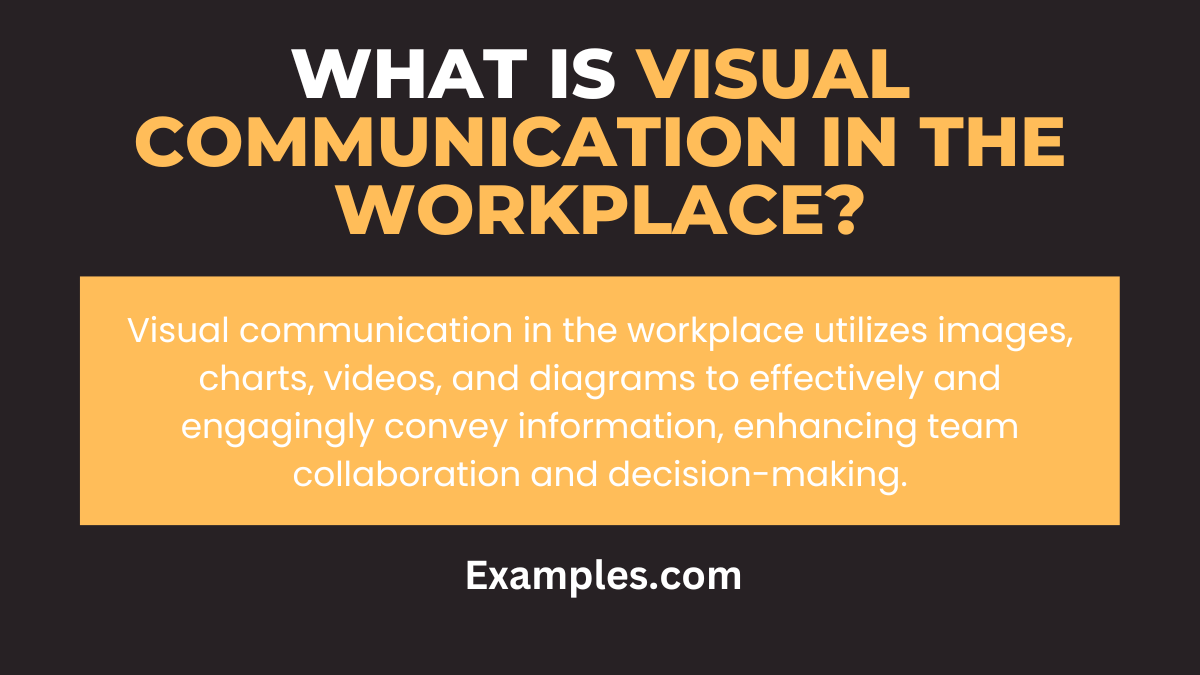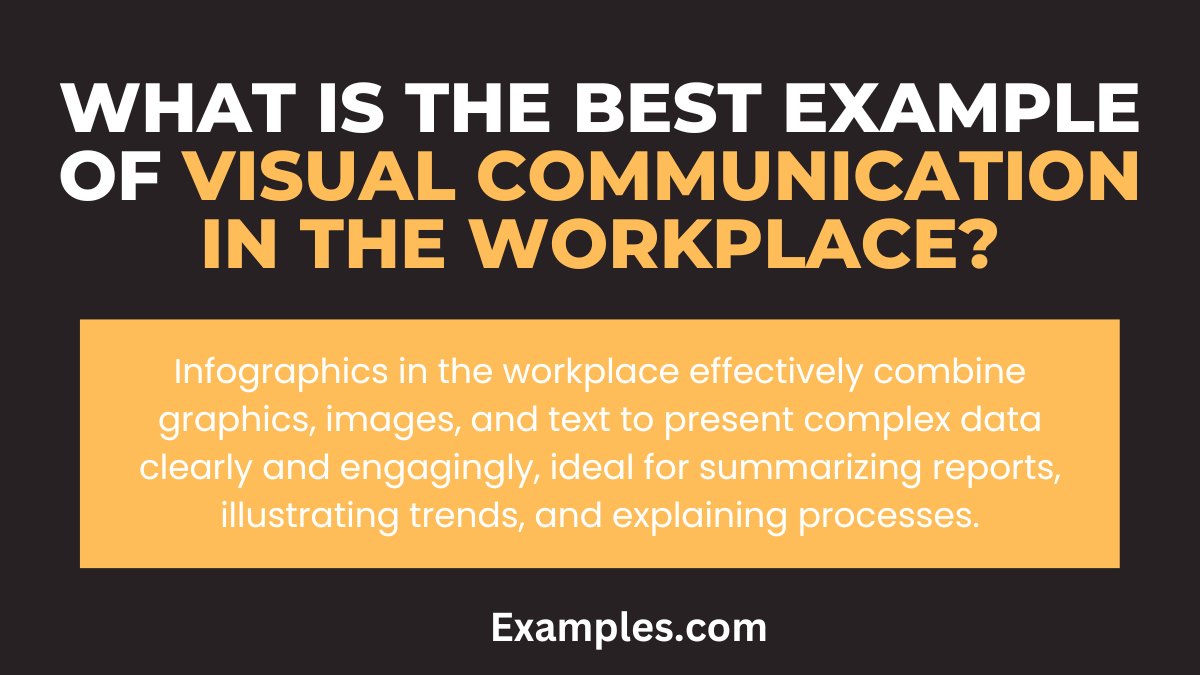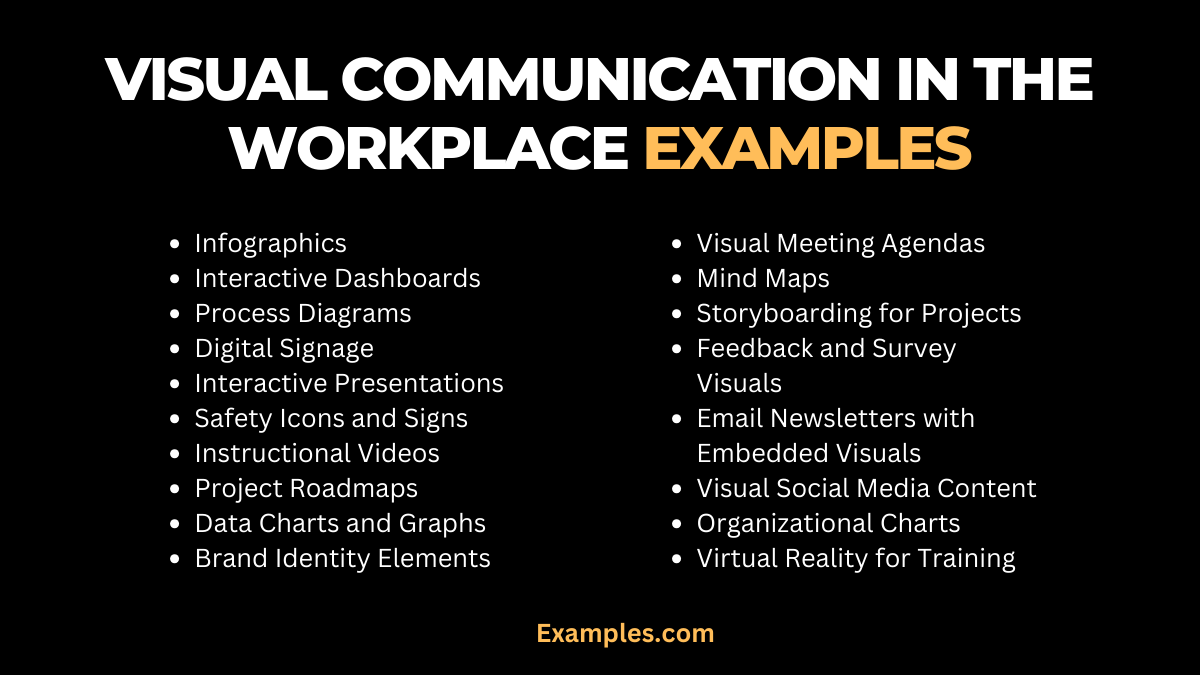19+ Visual Communication in the Workplace Examples
In today’s dynamic business landscape, “Visual Communication in the Workplace” stands as a crucial tool for enhancing efficiency and clarity. This complete guide delves into the essence of visual communication, providing rich, real-world Communication Examples to illustrate its impact. From graphical presentations to digital displays, we explore various strategies and tools that revolutionize the way information is conveyed in professional settings. Discover how to leverage visual communication for better collaboration, decision-making, and overall workplace productivity.
Download Importance of Visual Communication in the Workplace PDF
What is Visual Communication in the Workplace?

Visual communication in the workplace refers to the use of visual elements, like images, charts, videos, and diagrams, to convey information, ideas, or messages. It’s a way of sharing ideas and information without relying solely on text or verbal communication. This approach can include anything from a simple graph in a report to an interactive digital presentation. The goal is to make communication more effective, engaging, and easy to understand, enhancing the way teams collaborate and make decisions in a professional setting.
What is the Best Example of Visual Communication in the Workplace?

One of the best examples of visual communication in the workplace is the use of infographics. Infographics are powerful tools that combine graphics, images, and texts to present complex data in a clear, concise, and visually engaging manner. They are particularly effective in a business setting for summarizing reports, illustrating trends, and explaining processes.
For instance, in a sales report, instead of listing numbers and percentages in a text-heavy document, an infographic can display this information through charts, graphs, and icons. This visual format makes it easier for team members to quickly grasp key data points, trends, and insights without needing to sift through dense paragraphs or complicated spreadsheets.
20 Visual Communication in the Workplace Examples

In the fast-paced corporate world, Visual Communication in the Workplace has emerged as a key tool for conveying complex ideas succinctly and effectively. Incorporating elements from Visual Communication Examples, this approach harnesses the power of imagery and design to enhance Visual Communication Skills. Whether it’s through Types of Visual Communication or understanding its Importance, visual communication transcends traditional text-based methods, making information more accessible and engaging. This method, essential across various sectors from Healthcare to Media, is reshaping how we perceive and interact with information in professional settings.
- Infographics: Condensing complex data into visually appealing, easy-to-understand graphics.
- Interactive Dashboards: Providing real-time data insights through engaging visual formats.
- Process Diagrams: Illustrating workflows and processes for clarity and efficiency.
- Digital Signage: Communicating messages dynamically in communal areas.
- Interactive Presentations: Engaging audiences with visually rich, interactive slides.
- Safety Icons and Signs: Ensuring workplace safety through universally understood visuals.
- Instructional Videos: Demonstrating procedures with clear visual and verbal guidance.
- Project Roadmaps: Outlining project timelines and milestones visually.
- Data Charts and Graphs: Translating statistics into visually digestible formats.
- Brand Identity Elements: Conveying company ethos and values through visual branding.
- Visual Meeting Agendas: Enhancing meeting efficiency with clear, visual outlines.
- Mind Maps: Facilitating brainstorming and idea generation visually.
- Storyboarding for Projects: Planning and previewing projects through sequential visuals.
- Employee Training Modules with Visuals: Enhancing learning and retention with visual aids.
- Feedback and Survey Visuals: Gathering and presenting feedback in visual formats.
- Email Newsletters with Embedded Visuals: Increasing engagement with visually appealing email content.
- Visual Social Media Content: Leveraging visuals for effective internal communication.
- Organizational Charts: Visually mapping out company structure and roles.
- Virtual Reality for Training: Providing immersive learning experiences.
- Augmented Reality for Product Demos: Enhancing understanding of products with interactive visuals.
Visual Communication in the Workplace for Employees
In today’s collaborative environments, Visual Communication in the Workplace for Employees is pivotal. It’s not just about sharing information but doing so in a manner that is engaging, clear, and memorable. Utilizing visual tools effectively can significantly boost comprehension and retention among employees, fostering a more productive and interconnected workplace. This approach harmonizes with varied learning styles, ensuring that every team member is on the same page, thereby enhancing overall workplace dynamics.
- Employee Onboarding Guides: Utilizing visual aids in onboarding guides helps new employees grasp company policies and culture quickly: “Welcome to our team! This illustrated guide will help you understand our workplace culture and expectations.”
Example: Interactive onboarding booklets with infographics and diagrams make complex procedures easy to understand. - Visual Performance Dashboards: Dashboards with graphs and metrics offer employees a clear view of their performance and goals. “Here’s your performance dashboard; it visually tracks your targets and achievements.”
Example: Real-time performance tracking with visual indicators provides immediate feedback to employees. - Visual Task Management Tools : Tools like Kanban boards visually organize tasks, enhancing clarity and productivity. “Use this Kanban board to manage and visualize your project tasks.”
Example: Kanban boards with color-coded tasks simplify project management and progress tracking. - Health and Safety Visual Guides: Illustrated safety protocols ensure that employees understand and remember important safety information. “These visual guides will walk you through our safety procedures.”
Example: Illustrated emergency procedure posters provide clear, quick references during critical situations. - Company Policy Infographics : Transforming complex policy documents into infographics makes them more accessible and engaging. “Our company policies are summarized in these easy-to-follow infographics.”
Example: Infographics detailing company policies offer an engaging way to communicate important rules and standards.
What are the Types of Visual Communication in the Workplace?
Visual communication in the workplace encompasses various forms, each serving distinct purposes and catering to different aspects of professional communication. Understanding these Types Visual Communication in the Workplace.
- Infographics: These are visual representations of information, data, or knowledge, intended to present complex information quickly and clearly. They are particularly useful in summarizing reports or statistics.
- Presentations: Slide-based presentations using tools like PowerPoint or Keynote are a staple in business settings. They combine text, images, charts, and videos to communicate ideas effectively.
- Videos: Corporate videos, whether instructional or informational, offer a dynamic way to engage employees and communicate complex topics in an understandable format.
- Interactive Displays: Touchscreens, interactive kiosks, and whiteboards encourage collaborative communication and are increasingly popular in modern offices.
- Visual Reports: These transform traditional, text-heavy reports into more visually engaging documents using charts, graphs, and bullet points.
- Data Visualization: Tools that turn data into visual graphs and charts are indispensable for making data-driven decisions and communicating findings.
What is Effective Visual Communication in the Workplace?

Effective visual communication in the workplace means utilizing visual elements in a way that enhances understanding, engagement, and retention of information. Here’s how it can be achieved:
- Clarity and Simplicity: The visual elements should be clear and easy to understand, avoiding unnecessary complexity or clutter.
- Relevance: Visuals must be directly relevant to the topic and should add value to the content, rather than serving as mere decoration.
- Consistency: Consistent use of colors, fonts, and styles in visual communication helps in maintaining professionalism and brand identity.
- Audience Awareness: Tailoring the visual communication style to the audience’s preferences and level of understanding is essential for effectiveness.
- Feedback Incorporation: Regularly gathering and incorporating feedback on visual communication methods ensures continuous improvement and relevance.
Why is Visual Communication Important in the Workplace?
Importance of Visual communication plays a crucial role in the modern workplace due to several reasons:
- Enhanced Understanding: Visual aids can make complex information more digestible, thereby enhancing overall comprehension among employees.
- Increased Engagement: Employees are more likely to engage with visually appealing content, leading to better attention and retention of information.
- Efficient Communication: Visuals can convey messages more quickly than text, leading to more efficient communication in a time-sensitive environment.
- Supports Diversity: Visual communication transcends language barriers, making it effective in diverse and inclusive workplaces.
- Boosts Creativity and Collaboration: Visual tools stimulate creative thinking and encourage collaborative work among team members.
Incorporating visual communication strategically in the workplace can lead to improved efficiency, better understanding, and enhanced employee engagement, making it a valuable asset in any corporate communication strategy.
How Does Visual Communication Impact Workplace Safety?
Visual communication in the workplace enhances safety by clearly conveying hazards, safety procedures, and emergency exits, thereby reducing accidents and ensuring quick response during emergencies.
How is Visual Communication Used in the Workplace?
Visual communication is used in the workplace through infographics, presentations, videos, and interactive displays to simplify complex information, boost engagement, and foster collaborative understanding among employees.
How to Improve Visual Communication in the Workplace?
To improve visual communication in the workplace, focus on clarity, relevance, and consistency. Tailor visuals to audience needs and regularly gather feedback for continuous improvement and effectiveness.
In conclusion, mastering visual communication in the workplace is not just a skill but a necessity in today’s fast-paced corporate world. It bridges gaps in understanding, fosters a more inclusive environment, and drives home key points that might be lost in textual communication. For those looking to deepen their knowledge and skills in this vital area, resources like UCLA’s Labor Studies M176: Visual Communication in Work and Organizing offer comprehensive insights and practical applications. This course is an excellent opportunity to understand the theoretical underpinnings and practical applications of visual communication in a labor context.
Moreover, developing robust communication skills, including visual aspects, is crucial for career advancement and effective workplace interaction. Online platforms like Coursera offer valuable resources, such as courses on Communication Skills that can help individuals enhance their ability to convey messages effectively in the workplace. These courses provide practical tips and strategies, directly applicable to improving one’s visual communication techniques. By leveraging such resources, professionals can significantly enhance their visual communication skills, making their workplace interactions more impactful and effective.



